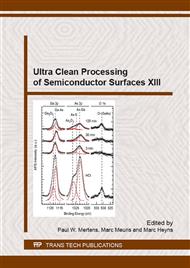p.251
p.255
p.260
p.265
p.270
p.277
p.285
p.291
p.299
Post CMP Wet Cleaning Influence on Cu Hillocks
Abstract:
Up to date, it is commonly reported in literature that the amount of copper hillocks is dependent on a) the total amount of residual Cu oxide after Cu CMP, and b) the Cu nitridation. The present work describes how that is only partially true: hillocks depend also on the kind of oxide and on the roughness of the surface after wet treatment. This contribution is even more important than what reported in literature. A tentative model for this behavior is proposed.
Info:
Periodical:
Pages:
270-276
Citation:
Online since:
September 2016
Keywords:
Price:
Сopyright:
© 2016 Trans Tech Publications Ltd. All Rights Reserved
Share:
Citation:


